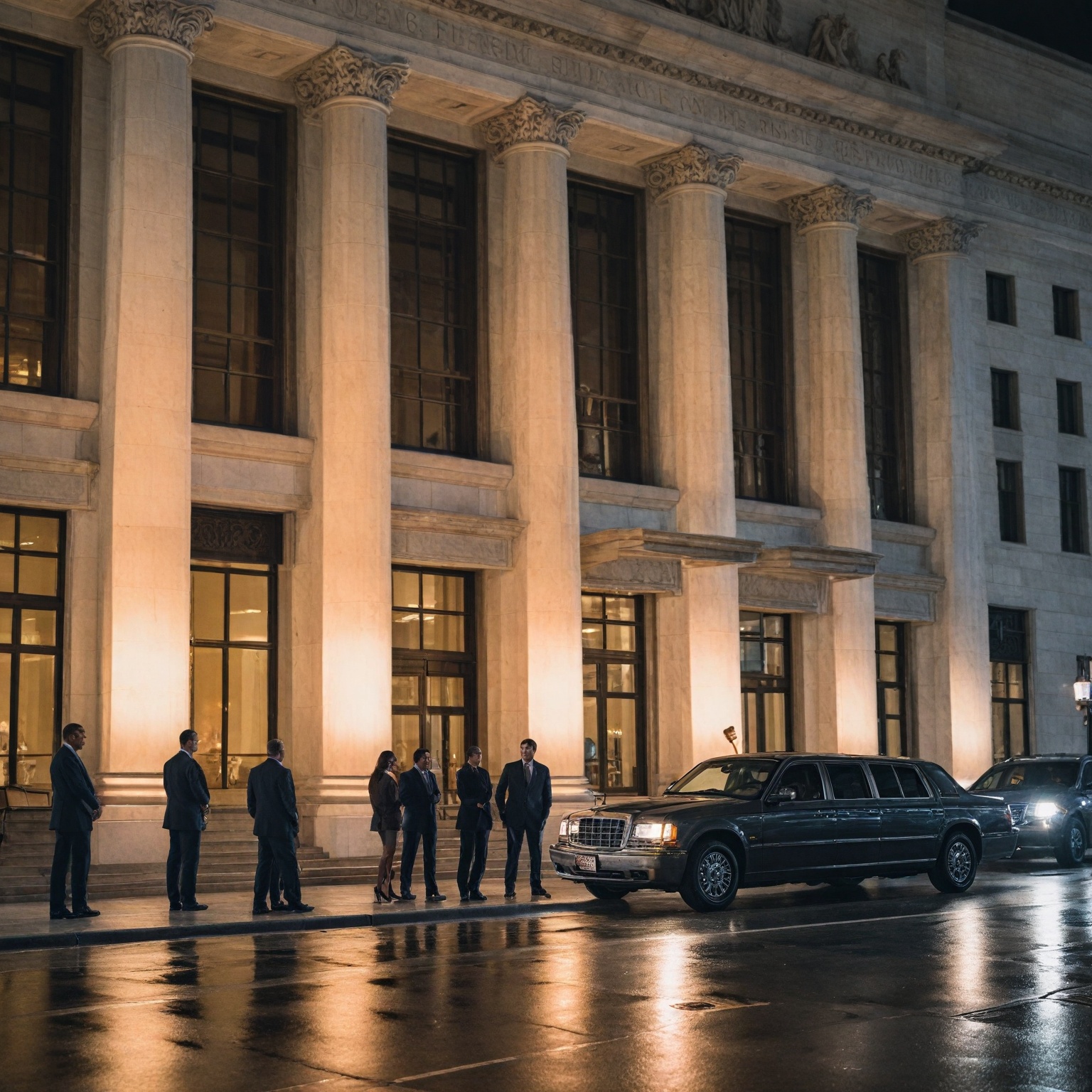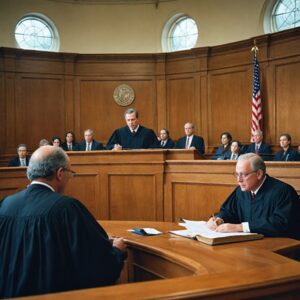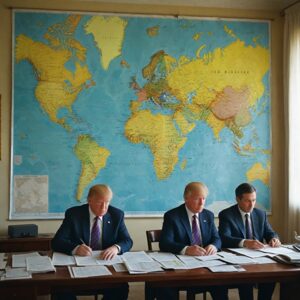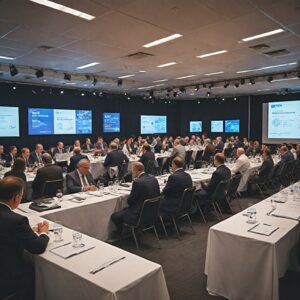Summary
President Donald Trump’s upcoming visit to the Federal Reserve headquarters in Washington, D.C., marks a significant and unprecedented escalation in his sustained campaign against Federal Reserve Chair Jerome Powell. Traditionally, U.S. presidents have respected the Fed’s institutional independence—a cornerstone of American economic governance that shields monetary policy from short-term political pressures. Trump’s decision to personally visit the Fed amid ongoing criticism of its interest rate policies and scrutiny of the institution’s costly headquarters renovation breaks with this norm and highlights mounting tensions between the executive branch and the central bank’s leadership.
The visit comes amid Trump’s repeated public rebukes of Powell for maintaining higher interest rates despite the president’s demands for rate cuts aimed at stimulating economic growth. Trump has also leveraged concerns over the Federal Reserve’s $2.5 billion renovation project as part of a broader effort to undermine Powell’s credibility and justify potential removal, a move that raises legal and constitutional questions about the limits of presidential authority over the Fed. Powell, in response, has reaffirmed the Fed’s commitment to independent monetary policy decisions focused on controlling inflation and promoting long-term economic stability, resisting political interference despite intense pressure.
This confrontation underscores a deeper, historically rooted tension between the Federal Reserve’s mandate to maintain economic stability and presidents’ political incentives to pursue short-term gains through monetary policy. While past administrations have occasionally criticized Fed actions, Trump’s direct and multifaceted campaign against Powell represents a marked departure from precedent, eliciting widespread concern among economists and policymakers about the potential erosion of the central bank’s independence and the risks this poses to economic stability.
The visit and the surrounding controversy thus highlight ongoing debates over the appropriate balance between democratic accountability and institutional autonomy in U.S. economic governance. Observers warn that increasing political pressure on the Federal Reserve could undermine confidence in the institution, destabilize financial markets, and complicate efforts to manage inflation and growth effectively, especially in the politically charged context of the 2024 presidential election cycle.
Background
The Federal Reserve, commonly known as the Fed, serves as the central bank of the United States and operates with a considerable degree of independence from the federal government. This independence is structurally reinforced by its quasi-governmental nature: the Board of Governors is appointed by the President and confirmed by Congress, but the institution itself does not rely on congressional appropriations and functions outside the direct control of the executive, legislative, or judicial branches. The Fed’s unique hybrid public-private structure emerged from a historical compromise designed to balance government oversight with private banking interests, a design that has persisted since the Federal Reserve Act of 1913.
The institution’s independent status is regarded as crucial for effective economic stewardship, helping to shield monetary policy from short-term political pressures that can undermine price stability and long-term economic growth. Nevertheless, this independence has occasionally been challenged by presidential administrations seeking to influence Fed policy, as evidenced in historical episodes such as President Richard Nixon’s pressure on the Fed in the early 1970s, which contributed to inflationary pressures.
In recent years, President Donald Trump has repeatedly criticized Federal Reserve Chair Jerome Powell, particularly for maintaining higher short-term interest rates despite calls from the administration to lower them to stimulate economic growth. Trump’s critiques intensified in 2023 and 2024 as the Fed kept interest rates at 4.3% after several increases, diverging from the president’s preference for lower borrowing costs. This friction culminated in Trump publicly questioning Powell’s management not only of monetary policy but also of an extensive renovation project at the Federal Reserve’s headquarters, suggesting that these issues could justify Powell’s dismissal.
Trump’s scheduled visit to the Federal Reserve headquarters in Washington is widely seen as an unprecedented move in the context of presidential respect for the Fed’s independence. Historically, presidents have generally refrained from direct confrontations with the central bank’s leadership. Trump’s visit marks a symbolic intensification of his campaign against Powell, bringing his longstanding criticism directly to the Federal Reserve’s doorstep. This development underscores the ongoing tension between maintaining the Fed’s institutional autonomy and the political pressures exerted by the executive branch.
Announcement of the Upcoming Visit
The White House announced on Wednesday that President Donald Trump would visit the Federal Reserve headquarters in Washington, D.C., at 4:00 p.m. on the following Thursday, marking a notable escalation in the administration’s pressure campaign against the central bank and its chair, Jerome Powell. This visit is particularly significant as it represents the first official trip to the Federal Reserve by an American president in nearly two decades, underscoring the symbolic challenge to the Fed’s longstanding independence from the executive branch.
The visit follows mounting criticism from President Trump regarding the Fed’s management of monetary policy, especially Powell’s refusal to lower interest rates despite Trump’s repeated public pressure. Additionally, the administration has targeted the Federal Reserve’s ongoing renovation project, a roughly $2.5 billion revamp of two buildings nearly a century old, which has faced scrutiny for its escalating costs and choice of materials, including the use of domestic marble.
Though the Federal Reserve did not immediately comment on the visit, it was noted that top administration officials were already scheduled to tour the construction site as a concession from the Fed aimed at deflecting criticism of the project. President Trump’s decision to visit the central bank in an official capacity—an uncommon move given the Fed’s intended independence—has been interpreted as a direct attempt to intensify pressure on Powell and the institution as a whole.
Campaign Against Chair Jerome Powell
Since the onset of his presidency, Donald Trump has maintained a notably antagonistic stance toward Federal Reserve Chair Jerome Powell, intensifying his criticism throughout his term and continuing into his campaign for the 2024 presidential election. A primary source of conflict has been Powell’s refusal to lower interest rates despite persistent demands from Trump, who repeatedly urged the Federal Reserve to enact immediate rate cuts to stimulate economic growth and reduce borrowing costs. Trump’s frustration escalated as inflation concerns mounted, yet Powell remained steadfast in prioritizing the Fed’s inflation-fighting mandate, attributing rising inflation in part to the tariffs imposed during the administration.
Trump’s criticisms of Powell have extended beyond monetary policy. The president and his administration have publicly questioned the costs of recent renovations to the Federal Reserve’s Washington, D.C. headquarters, which originally were projected at $1.9 billion but increased to $2.5 billion due to unforeseen conditions. The Trump administration has used these rising costs as a pretext to justify potential dismissal of Powell, a move that would challenge the Federal Reserve’s political independence and provoke legal uncertainty. Powell has responded by requesting an inspector general review of the renovation expenses and posting explanatory materials on the Fed’s website to address the criticisms.
Despite the sustained pressure and public rebukes, Powell has remained resolute in his commitment to serve out the remainder of his term, which runs through May 2024, and has emphasized the importance of insulating monetary policy decisions from political influence. He has explicitly stated that the Fed’s actions will not be dictated by political considerations but will focus on achieving its dual mandate of stable prices and maximum employment. This tension represents a departure from previous presidential critiques of the Federal Reserve, as Trump’s persistent and multifaceted campaign against Powell has been described as a dangerous deviation from the norm, risking the erosion of the institution’s long-established independence.
This campaign against Powell highlights the inherent conflict between the short-term political objectives of the presidency and the Federal Reserve’s long-term economic mandate. While presidents often seek low interest rates to bolster immediate economic growth and voter approval, the Fed must balance these pressures against the risks of unchecked inflation and financial instability. The resulting friction exemplifies the structural safeguards designed by the Framers of the Constitution to ensure that the Federal Reserve remains an independent entity insulated from direct political control. Nonetheless, Trump’s efforts, supported by coordinated amplification from his advisers, have significantly intensified the public and bureaucratic scrutiny of Powell’s leadership in the lead-up to the 2024 election cycle.
Historical and Institutional Context
The Federal Reserve System was established in 1913 as a hybrid public-private institution designed to balance competing interests between government oversight and private banking concerns. This structure emerged from a hard-fought legislative process aimed at preventing undue government intervention in the banking sector while ensuring sufficient public accountability. Its unique framework blends centralized and decentralized elements, reflected in the roles of the Board of Governors and the regional Reserve Banks, respectively, which together aim to insulate monetary policy decisions from direct political influence.
Formally, the Federal Open Market Committee (FOMC) meets regularly—typically eight times a year in Washington, D.C.—to deliberate on monetary policy. Nonvoting Reserve Bank presidents also participate in these discussions, emphasizing the system’s broad input and collaborative approach. The Fed’s independence is further secured by its funding mechanism, which does not rely on congressional appropriations, and the lengthy 14-year terms of its Board of Governors, whose appointments are staggered and confirmed by Congress to avoid synchronization with presidential election cycles.
Historically, the Federal Reserve has maintained considerable autonomy in its monetary policy decisions, which are designed to promote long-term economic stability, such as controlling inflation and preventing financial crises. Nevertheless, there have been notable instances, particularly between 1933 and 2016, where presidential pressure influenced the Fed’s actions, occasionally at the expense of price stability. The tension between short-term political goals and long-term economic objectives has been a recurring theme, with presidents often seeking policies that yield immediate benefits for their constituencies, while the Fed’s mandate requires a focus on sustainable economic health.
The institution’s insulation from political pressure has been supported by both tradition and formal structures. Since the Clinton administration, for example, there has been a norm against presidential interference in Federal Reserve policy, a norm largely respected through subsequent administrations until recent years. This independence is considered crucial not only domestically but also internationally, as evidence suggests that countries with politically independent central banks tend to achieve better economic outcomes.
Despite its independence, the Federal Reserve is not entirely detached from government oversight. Its governors, while serving long terms, are presidential appointees confirmed by the Senate, and the Fed must operate within the broader context of the government’s economic and fiscal policies. Executive branch regulatory review processes explicitly exclude the Federal Reserve’s monetary policy activities, further protecting its decision-making autonomy. However, mechanisms such as congressional oversight and the requirement to report to Congress help maintain a degree of accountability without compromising independence.
Recent political dynamics have challenged this established balance. Unlike past presidents who have occasionally criticized Federal Reserve decisions in a limited and traditional manner, President Trump’s persistent and public campaign against Chairman Jerome Powell marks a notable departure from precedent and has raised concerns about the potential erosion of the Fed’s independence. This intensifying pressure on the Federal Reserve’s leadership highlights ongoing debates about the appropriate degree of political accountability versus independence for the central bank—a debate with deep historical roots and significant implications for the U.S. economy.
Reactions to the Upcoming Visit
President Donald Trump’s planned visit to the Federal Reserve’s construction site has been widely interpreted as a significant escalation in his ongoing campaign to pressure Federal Reserve Chair Jerome Powell. Traditionally, U.S. presidents do not visit the central bank in an official capacity, underscoring the longstanding independence of the Federal Reserve from the White House. This visit, therefore, has raised concerns about political interference in monetary policy decisions.
Trump publicly criticized Powell for keeping interest rates “too high,” attributing this stance to political motivations despite the strong state of the economy. He stated, “People aren’t able to buy a house because this guy is a numbskull, he keeps the rates too high, and probably is doing it for political reasons”. Such comments reflect a rare and direct challenge to the Fed’s independence, a principle that has traditionally shielded monetary policy from executive branch influence.
The Federal Reserve is structured to operate independently: its Board of Governors members serve staggered 14-year terms that do not align with presidential cycles, and its monetary decisions do not require presidential or congressional approval. Moreover, the Fed does not receive direct funding from Congress, which further insulates it from political pressures. This institutional design aims to maintain stable economic governance by preventing short-term political considerations from influencing monetary policy.
Despite these safeguards, the Trump administration has intensified its public and bureaucratic efforts to influence the Fed. Office of Management and Budget Director Russell Vought publicly criticized the Federal Reserve’s $2.5 billion headquarters renovation, calling for an investigation and suggesting potential legal violations by Powell. These moves have been viewed as part of a broader campaign to undermine Powell’s leadership and to pressure the Fed into lowering interest rates ahead of the 2020 election.
In response, Powell has resisted these pressures, emphasizing the Fed’s commitment to independent decision-making. He has also requested an inspector general review of the renovation project to ensure transparency and accountability amid heightened scrutiny. The Fed has publicly defended the renovation, explaining the increased costs and necessity of the project.
Observers note that while political pressures on central banks are not unprecedented—such as those experienced during the Nixon and Johnson administrations—the explicit nature and intensity of the Trump administration’s campaign represent a notable challenge to the Fed’s independence. Research suggests that such political interference can lead to inflationary pressures and destabilize economic policy over time. Nonetheless, the institutional design of the Federal Reserve aims to balance these conflicting pressures and maintain a coherent monetary policy insulated from immediate political influence.
Strategic Timing and Political Implications
Donald Trump’s upcoming visit to the Federal Reserve is a significant and unusual move in the context of U.S. presidential interactions with the central bank. Traditionally, American presidents have respected the Federal Reserve’s independence, which is both legally and practically insulated from political pressures exerted by elected officials. Trump’s decision to personally visit the Fed chair amid ongoing criticism signals a marked departure from these established norms and reflects a strategic effort to intensify his campaign against Chair Jerome Powell.
The timing of the visit is politically charged, occurring during Trump’s 2024 presidential campaign, as he seeks to capitalize on economic issues to bolster his electoral prospects. By bringing his criticisms directly to the Federal Reserve, Trump underscores his belief that monetary policy decisions—such as maintaining higher interest rates—are influenced by political motivations rather than sound economic judgment. His public remarks accusing Powell of keeping rates “too high” for political reasons and blaming the Fed chair for economic hardships faced by constituents exemplify this narrative.
This episode reflects a broader tension between the Federal Reserve’s mandate to prioritize long-term economic stability and presidential incentives to pursue short-term political gains. While the Fed aims to prevent unchecked inflation by controlling spending and credit costs, presidents often seek policies that deliver immediate benefits to voters, such as lower interest rates and easier access to credit. Trump’s campaign against Powell, including the threat to remove him—a move complicated by legal protections that limit presidential authority to fire a Fed chair without cause—exemplifies the potential for conflict between these competing priorities.
Historically, the Federal Reserve’s structure was designed to balance independence with accountability, avoiding undue influence from political actors while maintaining responsiveness to economic conditions. However, analyses of past presidential interactions with the Fed reveal that political pressure has occasionally influenced monetary policy, particularly during the mid-20th century, contributing to inflationary outcomes. Trump’s actions can be seen as a continuation of this dynamic, albeit more overt and sustained than recent presidential predecessors, who generally refrained from direct intervention or public criticism of the Fed’s decisions.
The strategic timing of Trump’s visit and campaign against Powell thus carries significant political implications. It challenges the long-standing convention of Fed independence, raises concerns about politicization of monetary policy, and reflects the broader debate over the balance between democratic accountability and economic governance. Critics warn that such pressure risks undermining confidence in the Federal Reserve and could destabilize financial markets if it leads to abrupt leadership changes or policy shifts motivated by electoral considerations rather than economic fundamentals.
Outcomes and Subsequent Developments
President Donald Trump’s visit to the Federal Reserve marked a significant escalation in his public campaign against Chair Jerome Powell, who had consistently resisted presidential pressure to lower interest rates for short-term political gains. This visit, the first presidential appearance at the Fed in three years, symbolized a direct challenge to the institution’s longstanding independence, traditionally respected by American presidents and insulated from political whims by legal and structural safeguards.
Following the visit, tensions between the White House and the Federal Reserve leadership remained high. The Trump administration intensified scrutiny of the Fed’s operations, notably focusing on the costly renovations of the Federal Reserve headquarters. Powell was compelled to formally respond to accusations of fiscal mismanagement and luxury spending raised by the White House Office of Management and Budget (OMB), asserting that the use of new domestic marble and other project decisions were justified and approved by relevant oversight agencies. Nonetheless, the National Capital Planning Commission launched an inquiry into Powell’s handling of the renovation, with White House officials criticizing the Fed leadership for mismanagement and a perceived cover-up.
The campaign against Powell highlighted the fundamental tension inherent in the Federal Reserve’s structure: its independence in monetary policymaking versus the political accountability demanded by elected officials. Experts and analysts pointed out that while the Fed’s autonomy enables it to make difficult long-term economic decisions free from electoral pressures, excessive political interference risks undermining this independence and, consequently, economic stability. The Trump administration’s approach underscored the risks posed when presidential demands for immediate economic benefits clash with the Fed’s mandate to prevent inflation and maintain financial stability.
This period of heightened political pressure on the Federal Reserve reignited discussions about reforming the institution’s governance. Proposals emerged emphasizing the need to balance democratic accountability with institutional independence, suggesting reforms that would strengthen oversight without compromising the Fed’s ability to resist short-term political influence. Historical analyses of political interference, such as during the Nixon and Johnson administrations, were cited to illustrate the inflationary consequences of such pressure and to argue for preserving the Fed’s insulated decision-making processes.
Ultimately, the confrontation between President Trump and Chair Powell during this time exemplified the enduring and complex relationship between U.S. presidential administrations and the Federal Reserve. It served as a cautionary episode about the potential consequences of politicizing monetary policy and the importance of maintaining the Fed’s independence to ensure sound economic outcomes for the country.
























